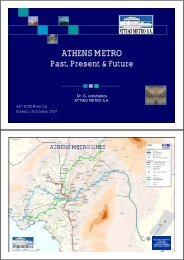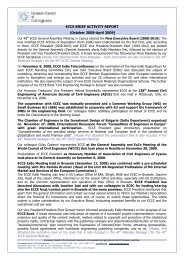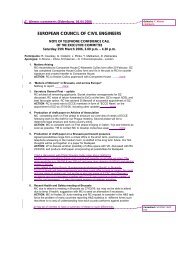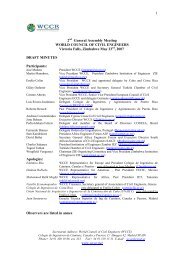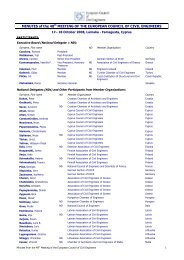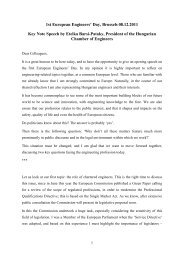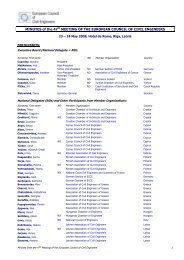A Closer Look at Prevailing Civil Engineering Practice - European ...
A Closer Look at Prevailing Civil Engineering Practice - European ...
A Closer Look at Prevailing Civil Engineering Practice - European ...
Create successful ePaper yourself
Turn your PDF publications into a flip-book with our unique Google optimized e-Paper software.
A <strong>Closer</strong> <strong>Look</strong> <strong>at</strong> <strong>Prevailing</strong> <strong>Civil</strong> <strong>Engineering</strong> <strong>Practice</strong>, Wh<strong>at</strong>, Why and How<br />
Vincent T. H. CHU<br />
Chapter 8. Tunneling<br />
1. How can Earth Pressure Balance TBM maintain stability of tunnel<br />
face<br />
Earth Pressure Balance (EPB) TBMs are used in excav<strong>at</strong>ing and<br />
advancing tunnels through any type of soft ground or soil condition,<br />
particularly below the w<strong>at</strong>er table. The EPB method consists of a cutting<br />
chamber loc<strong>at</strong>ed behind the cutterhead. This chamber is used to mix the<br />
soil with w<strong>at</strong>er foam. It is maintained under pressure by the mucking<br />
system. The ground <strong>at</strong> the cutting face is supported by earth pressure by<br />
balancing the advancement of the tunnel with the discharge r<strong>at</strong>e of the<br />
excav<strong>at</strong>ed soil.<br />
The underlying principle of the EPB method is th<strong>at</strong> the excav<strong>at</strong>ed soil itself<br />
is used to provide continuous support to the tunnel face by balancing earth<br />
pressure against the forward pressure of the machine. The thrust forces<br />
gener<strong>at</strong>ed from rear section of TBM is transferred to the earth in the<br />
cutterhead chamber so as to prevent uncontrolled intrusion of excav<strong>at</strong>ed<br />
m<strong>at</strong>erials into the chamber. When the shield advances <strong>at</strong> the face of<br />
excav<strong>at</strong>ion, the excav<strong>at</strong>ed soil is then mixed together with a special foam<br />
m<strong>at</strong>erial which changes its viscosity or thickness and transforms it into a<br />
flowing m<strong>at</strong>erial. This muck is then stored and is used to provide support<br />
and to balance pressure <strong>at</strong> the tunnel face during the excav<strong>at</strong>ion process.<br />
2. Why do Slurry Shield TBMs have difficulty when tunneling in clay<br />
In Slurry Shield TBMs, the slurry forms a filter cake on the face of<br />
excav<strong>at</strong>ion which has the following purposes:<br />
(i) It provides the surface for slurry pressure to act on.<br />
(ii) It acts as a seal against the y of groundw<strong>at</strong>er into the tunnel.<br />
(iii) In case the TBM breaks down, this filter cake serves as a sealing<br />
membrane <strong>at</strong> the tunnel face which allows man-entry into the<br />
excav<strong>at</strong>ion and working chamber upon provision go compressed air.<br />
Slurry Shield TBMs are widely used for non-cohesive soils ranging from<br />
fine-grained sand to coarse-grained gravel. It is less suitable when<br />
oper<strong>at</strong>ing in clay because:<br />
(i) Most slurry separ<strong>at</strong>ion plant could not separ<strong>at</strong>e clay from slurry. As<br />
59






